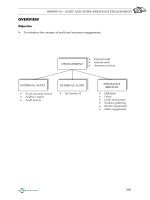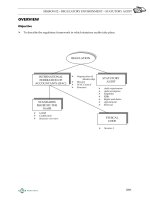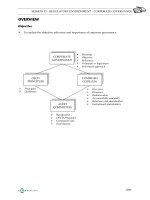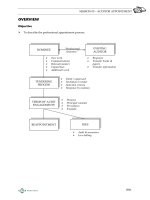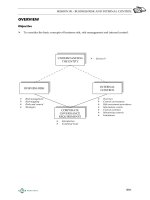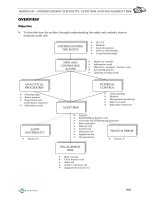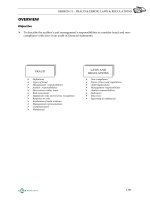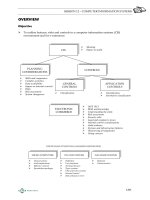ATC f8 materials for jun08 session study systemf8 AA (int)session03 j08
Bạn đang xem bản rút gọn của tài liệu. Xem và tải ngay bản đầy đủ của tài liệu tại đây (314.82 KB, 18 trang )
SESSION 03 – REGULATORY ENVIRONMENT – CORPORATE GOVERNANCE
OVERVIEW
Objective
To explain the objective, relevance and importance of corporate governance.
CORPORATE
GOVERNANCE
OECD
PRINCIPLES
Meaning
Objective
Relevance
Voluntary or legislation
Risk based approach
COMBINED
CODE (UK)
Principles
Guidelines
AUDIT
COMMITTEES
Overview
Directors
Remuneration
Accountability and audit
Relations with shareholders
Institutional shareholders
Background
OECD Principles
Combined Code
Expectations
0301
SESSION 03 – REGULATORY ENVIRONMENT – CORPORATE GOVERNANCE
1
CORPORATE GOVERNANCE
1.1
Meaning
There is no single, accepted definition of corporate governance. Corporate governance
as a specific discipline is relatively new. As beauty “lies in the eyes of the beholder”, so
does the answer to the question “what exactly is corporate governance?”
There is a wide range of definitions laying along the range from a narrow view that it is
restricted to the relationship between a company and its shareholders (agency theory)
through to the much wider view that corporate governance is a complex web of direct,
indirect and ever changing relationships between the entity and its stakeholders
(stakeholder theory).
Example 1
Identify the stakeholders of a typical business entity.
Solution
The Organisation for Economic Cooperation and Development (OECD) defines
corporate governance as:
“The system by which business corporations are directed and controlled. The corporate
governance structure specifies the distribution of rights and responsibilities among
different participants in the corporation … and spells out the rules and procedures for
making decisions on corporate affairs. By doing this, it also provides the structure
through which the company objectives are set, and the means of attaining those
objectives and monitoring performance.”
Participants include the board, managers, shareholders and other stakeholders –
hence “society” in the broader definition.
Other explanations include:
“The way in which organisations are directed and controlled”
0302
SESSION 03 – REGULATORY ENVIRONMENT – CORPORATE GOVERNANCE
“The system of checks and balances, both internal and external to companies, which
ensures that companies discharge their accountability to all stakeholders and act in
a socially responsible way in all areas of their business activity.”
“The ethical corporate behaviour by directors or others charged with governance in
the creation of wealth for all stakeholders.”
“The way in which the affairs of corporations are handled by the corporate boards
and officers.”
“It is the relationship among various participants in determining the direction and
performance of companies consistent with the public good.”
“The way of promoting corporate fairness, transparency, independence, integrity
and accountability.”
1.2
Objective
The ultimate objective of a business is increasing long-term shareholder value by
enhancing economic performance.
Research has shown that entities that take account of the interests of all stakeholders
are, over the longer term, more successful and more prosperous than entities that do
not.
This is achieved through:
integrity, transparency and accountability in business activity;
compliance with law and regulation; and
securing reputation and confidence in attracting inward investment.
It is reflected by how those charged with governance provide stewardship in order to:
achieve corporate objectives;
balance corporate objectives with the expectations of society; and
provide appropriate accountability to stakeholders.
In general, governance responsibilities involve a number of oversight activities,
including matters relating to:
entity strategy development and implementation;
economic development, including mergers and acquisitions;
appointment of professional operating management executives;
compensation of executives;
formation of adequate accounting systems and related internal controls over
financial reporting, operations and compliance with laws and regulations; and
engaging independent auditors.
0303
SESSION 03 – REGULATORY ENVIRONMENT – CORPORATE GOVERNANCE
1.3
Relevance
Increases in size, global reach and shareholder base have moved shareholders further
away from the management and control of the companies they invest in.
Boards of directors provide stewardship over the resources entrusted to them, but
corporate governance stewardship responsibilities are increasingly placed on the nonexecutive members of the board who are, or should be, more independent from the dayto-day operations of the entities and the actions of the professional operating managers.
Professional managers running day-to-day operations of large shareholder-owned
companies have in some cases caused serious losses to the shareholders through
mismanagement or fraudulent financial reporting.
Corporate governance provides the means to exercise greater control over professional
operating management. The empirical results of studies show that the presence of
outside directors helps in preventing or reducing financial statement fraud.
If governance responsibilities are taken seriously and performed with intelligence,
competence and due regard for the stakeholders, society stands a better chance:
of being protected from financial statement fraud, money-laundering, etc; and
that public company personnel will have an early focus on going concern issues,
appropriate business strategies, and the implementation of the strategies.
There is a consensus amongst analysts and policymakers that improving corporate
governance of companies is critical to generating sustainable growth in the future.
1.4
Voluntary or legislated codes
Corporate governance codes are either voluntary codes (eg Russia, Saudi Arabia)
comply or explain codes that are often incorporated into stock exchange regulations
(e.g. Combined Code in the UK, Sweden) or fully legislated codes (e.g. Sarbanes-Oxley
Act in the USA).
The prescriptive approach of the US Sarbanes-Oxley Act (SOX) is in stark contrast to the
“comply or explain” approach taken by the Combined Code in the UK.
Under SOX, the rules have to be followed, or stiff penalties will be raised against the
company and its directors. Some of the entities under SOX, consider the rules to be too
onerous and not cost effective – thus they are seeking to de-list.
With the Combined Code, if a company does not comply with any of the requirements
of the Code, it has to explain why it has not done so – whilst such disclosures may be
relevant, many entities consider the potential impact on their reputation and market
standing of not complying a sufficient deterrent to ensure they do comply. Smaller
companies will be able to balance the cost against the benefit in deciding whether or not
to disclose.
0304
SESSION 03 – REGULATORY ENVIRONMENT – CORPORATE GOVERNANCE
Codes that are voluntary or a requirement of a stock exchange can be easily updated to
take into account changes in the business environment and stakeholder requirements.
Those that are subject to the due process of regulatory law, may not be able to do so so
quickly.
Codes that are required by law, will be supported by legal penalties and sanctions, e.g.
fines and jail terms for directors who breach the rules. The threat of such sanctions may
result in the directors of an entity becoming ultra cautious and complying to the letter of
the law – this may take resources that could be more effectively used in running the
business and lead to a “tick box” mentality.
Where the code is voluntary, compliance by specific companies sends a signal to
investors to help them identify candidates that match their criteria for investment. Such
market based reactions are a powerful inducement for other companies to follow.
Voluntary codes do make it difficult to compare companies and make investment
decisions. However, research shows that investors tend to favour companies that apply
corporate governance procedures over those that do not.
In all cases, a balance must be struck between developing a Code and the ability of the
directors of a business to run that business for the benefit of the stakeholders.
1.5
Risk based approach
Interestingly, there is an argument that it is not the introduction of good corporate
governance that will deliver improvements to an entity, but the fact that a lack of good
governance will result in poor corporate financial performance – a negative impact.
It is argued that good corporate governance is naturally progressive and a natural
response to the various scandals resulting from poor governance. Good corporate
governance practice (that balances the requirements of all stakeholders) is a progressive
norm and as such, companies will benefit from the expectations generated by
maintaining the norm.
For example, one investment fund invested in companies that were considered to
have poor corporate governance procedures. Using their shareholder rights, the
fund forced the management to implement sound corporate governance policies.
The gains made by the fund were substantial as the market price of the shares
reflected the “norming” of the business to “best practice”.
Basically, there is a risk that weak corporate governance will lead to financial losses.
Strong corporate governance will minimise such risk. This is reflected within the UK
Combined Code for management and the corporate governance process to adopt a risk
based approach.
2
OECD PRINCIPLES
The OECD Principles of Corporate Governance have, since their introduction in 1999,
and updating in 2004, become the most widely accepted corporate governance
benchmark in influencing the drafting of national codes.
0305
SESSION 03 – REGULATORY ENVIRONMENT – CORPORATE GOVERNANCE
2.1
Principles
Protection of shareholders’ rights and key ownership functions.
Ensuring the equitable treatment of all shareholders, including minority and foreign
shareholders.
Recognising the rights of stakeholders (including employees) as established by law and
encouraging active co-operation between corporations and stakeholders in creating
wealth, jobs, and the sustainability of financially sound enterprises.
Ensuring that timely and accurate disclosure (transparency) is made on all material
matters regarding the corporation, including the financial situation, performance,
ownership, and governance of the company.
Ensuring the strategic guidance of the company, the effective monitoring of
management by the board, and the board’s accountability to the company and its
shareholders (the responsibilities of the board).
2.2
Guidelines
2.2.1
Protection of shareholders’ rights …
Guidelines include:
Secure methods of ownership, registration, and transfer of shares.
Shareholders to receive relevant information on the corporation on a timely and
regular basis including the voting procedures that govern general shareholder
meetings.
To participate in, and to be sufficiently informed on, decisions concerning
fundamental corporate changes including effective participation in general
shareholder meetings.
2.2.2 Equitable treatment of all shareholders …
Guidelines include:
All shareholders have effective redress for violation of their rights.
All shareholders of the same series of a class are treated equally.
Minority shareholders are protected from abusive actions of the majority holders.
Any changes in voting rights are approved by those classes of shares which are
negatively affected.
Processes and procedures for general shareholder meetings allow for equitable
treatment of all shareholders.
Insider trading and abusive self-dealing prohibited.
0306
SESSION 03 – REGULATORY ENVIRONMENT – CORPORATE GOVERNANCE
Members of the board and key executives disclose to the board whether they,
directly, indirectly or on behalf of third parties, have a material interest in any
transaction or matter directly affecting the corporation.
2.2.3 Recognising the rights of stakeholders …
Guidelines include:
Effective redress for violation of their rights.
Access to relevant, sufficient and reliable information on a timely and regular basis.
Able to freely communicate their concerns about illegal or unethical practices to the
board and their rights should not be compromised for doing this.
2.2.4
Ensuring timely and accurate disclosure is made on all material matters …
Guidelines include:
Financial and operating results of the company, company objectives and major
share ownership and voting rights.
Information about the board members and key executives on their remuneration
policy, qualifications, the selection process, other company directorships and
whether they are regarded as independent by the board.
Related party transactions, foreseeable risk factors and issues regarding employees
and other stakeholders.
Governance structures and policies, in particular, the content of any corporate
governance code or policy and the process by which it is implemented.
Annual audit undertaken by an independent, competent and qualified auditor
accountable to the shareholders.
2.2.5
Ensuring the strategic guidance of the company …
The concept here is that the board as a whole (including independent non-executive
directors) are able to monitor the day-to-day activities of the entity’s executive
management and in particular the CEO (chief executive officer).
No one individual executive, or group of executives, should dominate the direction and
strategy of the company, and, in particular, to the benefit of themselves or others under
their influence.
A significant factor in nearly all financial scandals has been the overriding
dominance of the CEO, either by themselves or in combination with the Chief
Financial Officer (CFO). This is further compounded where the CEO also acts as
the Chairman of the Board.
For key oversight roles, independent committees should be established, e.g. the Audit
Committee, the Nomination Committee, the Remuneration Committee.
0307
SESSION 03 – REGULATORY ENVIRONMENT – CORPORATE GOVERNANCE
Guidelines consider that the board (as a whole) should:
Act on a fully informed basis, in good faith, due diligence, care, and in the best
interests of the company and the shareholders.
Apply high ethical standards and exercise objective independent judgment on
corporate affairs, taking into account the interests of all stakeholders.
Review and guide corporate strategy, major plans of action, risk policy, annual
budgets and business plans; set performance objectives; monitor implementation
and corporate performance; oversee major capital expenditures, acquisitions and
divestitures.
Ensure the integrity of the corporation’s accounting and financial reporting
systems, e.g. independent audit, control systems, risk management procedures,
financial and operational control, compliance with the law and regulations.
Monitor and manage potential conflicts of interest of management, board members
and shareholders, including misuse of corporate assets and abuse in related party
transactions.
Assign independent non-executive board members to tasks where there is a
potential for conflict of interest, e.g. ensuring the integrity of financial and nonfinancial reporting, the review of related party transactions, nomination of board
members and key executives, and board remuneration.
Select, compensate, monitor and, when necessary, replace key executives and
oversee succession planning.
Align key executive and board remuneration with the longer term interests of the
company and its shareholders.
Monitor effectiveness of governance practices and make changes as needed.
3
COMBINED CODE (UK) — EXAMPLE OF CORPORATE
GOVERNANCE APPLICATION
3.1
Overview
3.1.1
History
Applies to companies listed on the London Stock Exchange (LSE).
The UK was the first country to implement corporate governance procedures with the
issue of the Cadbury Report in 1992 (following a series of so-called UK Enron financial
scandals in the 1980s). This was followed by several other reports, all of which were
later consolidated into a “Combined Code” in June 1998.
0308
SESSION 03 – REGULATORY ENVIRONMENT – CORPORATE GOVERNANCE
The current code was last updated in July 2003 and applied for reporting years
commencing on or after 1st November 2003, i.e. year ends of 30th November 2004 and
after. A review of the Code took place during 2005/6 resulting in limited minor
amendments being made in June 06.
3.1.2
Basic elements
Comprises two sections (companies and institutional shareholders) and five elements
(directors, remuneration, accountability and audit, relations with shareholders and
institutional shareholders). See below for details on each element.
Contains related guidance and good practice suggestions:
Internal control and risk assessment (the Turnbull Guidance – see Sessions 8 & 9)
Audit committees (the Smith Guidance)
Chairman and non-executive directors (the Higgs Guidance)
All companies have to report on how they apply the principles of the Code (extensive
guidance is included within the Code of what needs to be disclosed within the report)
and either confirm that they have complied throughout the financial year with the code
provisions or, where they do not, provide an explanation as to why not (comply or
explain approach).
In addition:
the board must confirm that there is an ongoing process for the identification,
evaluation and monitoring of significant risks; and
summarise the process by which they have reviewed the effectiveness of the
internal control system (see Sessions 8 & 9).
3.1.3
London Stock Exchange (LSE) audit requirements
External auditors are not required by the Code to report on management’s application
of the Code. They are, however, required by the Listing Rules of the LSE to review and
report on whether the corporate governance statement reflects the entity’s compliance
with specific elements of the Code as follows:
The directors’ responsibility for preparing financial statements explained.
Review of the effectiveness internal control carried out and reported to
shareholders.
Audit committee established of at least three independent non-exec directors. One
member must have recent and relevant financial experience.
Role and responsibilities of the audit committee set out in writing and includes
details as required by the Code.
Terms of reference of the audit committee, including its role and the authority
delegated to it by the board, made available/described in report.
0309
SESSION 03 – REGULATORY ENVIRONMENT – CORPORATE GOVERNANCE
Arrangements are in place by which staff may, in confidence, raise concerns with
the audit committee over possible improprieties of financial reporting or other
matters (“whistle blowing”).
Arrangements are in place for the independent investigation of such matters and
for appropriate follow-up action.
The audit committee has monitored and reviewed the effectiveness of the internal
audit activities.
Where there is no internal audit function, the audit committee has considered
whether there is a need and made recommendations to the board.
Reasons for the absence of internal audit have been given in the annual report.
The audit committee has primary responsibility for making a recommendation on
the appointment, reappointment and removal of the external auditors.
If the board did not accept the recommendation, a statement from the audit
committee explaining the recommendation and reasons why the board has taken a
different position, is included in the annual report and in any papers to the
members recommending appointment or re-appointment.
The annual report explains to shareholders how, if the auditor provides non-audit
services, auditor objectivity and independence is safeguarded.
3.2
Directors
Deals with the board, the chairman and chief executive, board balance and
independence, appointment and re-election to the board, information and professional
development of board members, performance evaluation.
Listed companies should have:
an effective board with clear division of duties between Chairman and CEO. They
cannot be the same individual (as this gives too much power to one individual) and
the Chairman should be non-exec;
a balance of executive and non-executive directors (so that no one group is
dominant, ie 50/50), each group receiving the same relevant, up to date
information (so that the board and non-executive directors can constructively
challenge the executive);
a requirement for the board to have formal and rigorous annual evaluations of their
performance covering all committees and individual directors;
no executive director holding more than one non-executive directorship with
another company; and
a formal, transparent and independent appointment process for new directors and
with all directors (including non-exec) submitting themselves regularly for reelection.
0310
SESSION 03 – REGULATORY ENVIRONMENT – CORPORATE GOVERNANCE
3.3
Remuneration
Deals with the level and make up of remuneration, service contracts and compensation,
procedures for developing remuneration policies.
There should be appropriate levels of remuneration with a formal and transparent
process for fixing that remuneration (i.e. use of an independent remuneration
committee) and full details disclosed in the company’s annual report.
3.4
Accountability and audit
Covers financial reporting, internal control, the audit committee and auditors.
The company should present a balanced and understandable assessment of its position,
maintain a sound system of internal control and establish formal and transparent
arrangements for the review of financial reporting, internal control principles and for
maintaining an appropriate relationship with the external auditors.
An audit committee of at least three, independent non-executive directors must be
established, with at least one member having recent, relevant financial experience.
The effectiveness of internal control (including financial, operational, compliance and
risk management systems) must be reviewed at least once each year.
3.5
Relations with shareholders
Deals with the dialogue with institutional shareholders and constructive use of the
annual general meeting (AGM).
Companies need to enter into a dialogue with institutional shareholders and use the
annual general meeting to communicate with private investors.
3.6
Institutional shareholders
Covers dialogue from institutional shareholders, their evaluation of governance
disclosures and voting.
Institutional shareholders should make considered use of their votes, be ready to enter
into a dialogue with companies and should give due weight to all factors when
evaluating a company’s governance arrangements.
Since the introduction of corporate governance codes within the UK, institutional
shareholders have become much more active in holding the CEO and board
accountable for their actions. No longer can CEOs expect “sleeping” loyalty from
institutional shareholders.
4
AUDIT COMMITTEES
The audit committee is now considered to be an essential part of the corporate reporting
process with the primary responsibility of overseeing, on behalf of the board, the
integrity of the financial reporting controls and procedures implemented by
management, to protect the interests of shareholders and other stakeholders.
0311
SESSION 03 – REGULATORY ENVIRONMENT – CORPORATE GOVERNANCE
4.1
Background
Audit committees existed in the 19th century.
Illustration 1
“Great Western Railway
Report of the Audit Committee
The auditors and Mr. Deloitte attended the Committee and explained the
various matters connected with the Finances and other departments of the
railway, which explanations were highly satisfactory.
The Committee consider the Auditors have performed their arduous duties with
great care and intelligence and therefore confidently recommend that they be
continued in office.
Benjamin Lancaster
Chairman
Paddington Station
22nd February, 1872”
Mandatory for domestic companies listed on the New York Stock Exchange since 1978.
Rules significantly updated by the Sarbanes-Oxley Act of 2002 following the singular
spectacular failure and ineffectiveness of the Enron audit committee.
Disclosure, by exception, in Annual Reports of UK listed companies a requirement of
the London Stock Exchange since 1993. Updated through the Combined Code of 1999
and 2003.
Specific guidance issued, within the UK, in 2002 on the establishment, membership,
role, responsibilities and relationship with the main board of audit committees – the
Smith Report.
From just a handful of capital markets requiring audit committees in the 1980s, at least
16 countries now require audit committees by law with a further 14 operating under a
“comply or explain” basis. Eight other countries operate alternative structures.
4.2
OECD Principles
Reference is made throughout the Principles, to the role of independent, non-executive
directors. Specific reference to an Audit Committee is made under the following
situations:
4.2.1
The annual audit conducted by independent, external auditors
It is increasingly common for external auditors to be recommended by an independent
audit committee of the board and to be appointed either by that committee/body or by
shareholders directly.
0312
SESSION 03 – REGULATORY ENVIRONMENT – CORPORATE GOVERNANCE
The Audit Committee is often specified as providing oversight of the internal audit
activities and should also be charged with overseeing the overall relationship with the
external auditor including the nature of non-audit services provided by the auditor to
the company.
4.2.2
External auditors accountability
That external auditors are recommended and appointed by an independent audit
committee (or appointed by shareholders following the committee’s recommendation)
can be regarded as good practice.
This practice clarifies that the external auditor should be accountable to the
shareholders and not directly to the executive management of an entity.
It also underlines that the external auditor owes a duty of due professional care to the
company rather than any individual or group of corporate managers that they may
interact with for the purpose of their work.
4.2.3
Conflicts of interest
It is important for a company’s board to encourage the reporting of unethical/unlawful
behaviour without fear of retribution.
In a number of companies either the Audit Committee or an ethics committee is
specified as the contact point for employees who wish to report concerns about
unethical or illegal behaviour that might also compromise the integrity of financial
statements.
4.2.4
Ensuring the integrity of the corporation’s accounting and financial reporting
systems, including risk management.
A company’s board will need to ensure that there is appropriate oversight of these
functions by senior management. Often, internal audit reporting directly to the board,
is used.
In some jurisdictions it is considered good practice for the internal auditors to report to
an independent audit committee of the board which is also responsible for managing
the relationship with the external auditor, thereby allowing a coordinated response by
the board.
It should also be regarded as good practice for the Audit Committee to review and
report to the board on the most critical accounting policies which are the basis for the
financial reports.
4.3
The UK Combined Code on Audit Committees
The Audit Committee consists of at least three members, all of whom must be
independent non-executive directors. At least one member must have recent and
relevant financial experience.
0313
SESSION 03 – REGULATORY ENVIRONMENT – CORPORATE GOVERNANCE
The main role and responsibilities of the committee members must be set out in written
terms of reference:
to monitor the integrity of the financial statements of the company, and any formal
announcements relating to the company’s financial performance, reviewing
significant financial reporting judgements contained in them;
to review the company’s internal financial controls and, unless expressly addressed
by a separate board risk committee composed of independent directors, or by the
board itself, to review the company’s internal control and risk management
systems;
to monitor and review the effectiveness of the company’s internal audit function,
and if there is no internal audit, consider annually if there is a need for internal
audit and make that recommendation to the board;
to make recommendations to the board, for it to put to the shareholders for their
approval in general meeting, in relation to the appointment, re-appointment and
removal of the external auditor and to approve the remuneration and terms of
engagement of the external auditor;
to review and monitor the external auditor’s independence and objectivity and the
effectiveness of the audit process, taking into consideration relevant UK
professional and regulatory requirements;
to develop and implement policy on the engagement of the external auditor to
supply non-audit services, taking into account relevant ethical guidance regarding
the provision of non-audit services by the external audit firm;
to report to the board, identifying any matters in respect of which it considers that
action or improvement is needed and making recommendations as to the steps to
be taken;
to review arrangements by which staff of the company may, in confidence, raise
concerns about possible improprieties in matters of financial reporting or other
matters and to ensure that arrangements are in place for the proportionate and
independent investigation of such matters and for appropriate follow-up action.
4.3.1
Internal audit
For internal audit, to specifically:
Approve the appointment or termination of the head of internal audit.
Ensure that the internal auditor has direct access to the board chairman and to the
Audit Committee and is accountable to the Audit Committee.
Review and assess the annual internal audit work plan.
Receive a report on the results of the internal auditors’ work on a periodic basis.
Review and monitor management’s responsiveness to the internal auditor’s
findings and recommendations.
0314
SESSION 03 – REGULATORY ENVIRONMENT – CORPORATE GOVERNANCE
Meet with the head of internal audit at least once a year without the presence of
management.
Monitor and assess the role and effectiveness of the internal audit function in the
overall context of the company’s risk management system.
4.3.2
External audit
For external audit, to specifically:
Approve the terms of engagement and the remuneration to be paid in respect of
audit services provided.
Ensure that the external auditors are independent of the company, eg:
−
−
−
discussion with the auditors;
review of their policies and processes to maintain independence; and
compliance with appropriate ethical guidelines.
Ensure that appropriate plans are in place (at the start of each annual audit cycle)
for the audit, e.g. the overall strategy, risk assessment, materiality, resources and
work plans.
Review, with the external auditors, the findings of their work, eg:
−
−
−
−
discussing major issues that arose during the audit (both resolved and
unresolved);
key accounting and audit judgements;
levels of error identified during the audit; and
discussing with management and auditors why certain errors remain
unchanged.
Review the audit representation letters (before signing by management).
Review the management letter and monitor management’s actions taken on its
recommendations.
Assess the effectiveness of the audit process, e.g.:
−
was the agreed audit plan met and where changes were made, understand the
reasons for such changes, including changes in perceived audit risks and the
work undertaken address those risks;
−
consider the robustness and perceptiveness of the auditors in their handling of
the key accounting and audit judgements identified and in responding to
questions from the audit committees, and in their commentary, where
appropriate, on the systems of internal control;
−
obtain feedback about the conduct of the audit from key people involved, e.g.
the finance director and the head of internal audit.
0315
SESSION 03 – REGULATORY ENVIRONMENT – CORPORATE GOVERNANCE
The audit committee should develop and recommend to the board the company’s
policy in relation to the provision of non-audit services by the auditor. The audit
committee’s objective should be to ensure that the provision of such services does not
impair the external auditor’s independence or objectivity. In this context, the audit
committee should consider:
whether the skills and experience of the audit firm make it a suitable supplier of the
non audit service;
whether there are safeguards in place to ensure that there is no threat to objectivity
and independence in the conduct of the audit resulting from the provision of such
services by the external auditor;
the nature of the non-audit services, the related fee levels and the fee levels
individually and in aggregate relative to the audit fee; and the criteria which
govern the compensation of the individuals performing the audit.
4.4
Expectations
Gone are the days when the audit committee would meet just before the annual general
meeting and rubber stamp what the directors had done – the nature of stakeholders’
expectations of the audit committee are now equivalent to those of the main board
members.
Such expectations have not only come about because of various financial reporting
scandals (both recent and past) but because of the wider requirements from
stakeholders for corporate accountability, social responsibility and the rejection of
“short-termism” .
Whilst the executive directors bear overall responsibility for the corporate strategy,
overseeing risks faced by the company, the controls related to those risks and the
financial information released to stakeholders (e.g. annual financial statements and
reports), the audit committee’s role is a non-executive one.
The audit committee should not seek to take an executive role but should aim to satisfy
itself that management has properly fulfilled its responsibilities. In doing so, the
committee members must have a sound understanding of the entity, the way it
operates, the environment it operates in and be independent of the company.
Whilst the role of the audit committee considers the risks and controls over the financial
reporting process, they must also consider the tax, environmental, legal and other
regulatory matters that have a material impact on the financial statements.
4.4.1
Advantages of audit committees
Play a valuable role through effective and informed oversight in helping to ensure
market, public and stakeholder confidence in high quality financial reporting.
Enables the board to delegate a thorough and detailed review of audit matters, both
internal and external. Again, this will enhance the environment for greater external
confidence in the entity.
0316
SESSION 03 – REGULATORY ENVIRONMENT – CORPORATE GOVERNANCE
Enables non-executive directors to contribute independent judgement on matters of
critical importance in running the enterprise (e.g. investment decisions, risk analysis)
and play a positive role in areas for which their skills are particularly fitted. It is of
particular importance that the chief executive of the enterprise and the chairman of the
audit committee are able to develop a respected, transparent, trusted and professional
working relationship.
Offers the external and internal auditors a direct link with non-executive directors.
Effective Audit Committees need to be able to investigate issues on their own initiative,
rather than as directed by the CEO. They must be clear about what they need to know
and determined to receive the information they require. Corporate governance codes
will not change the mindset of a CEO/CFO determined to carry out a fraud. But an
effective Audit Committee (together with effective internal and external auditing)
should act as a significant deterrent and minimise the opportunities for destructive
fraud to be carried out undetected over a period of time.
4.4.2
Disadvantages of audit committees
May be seen as an unnecessary legal or regulatory burden placed upon the board – “we
know how to run the company without anybody else trying to tell us what to do”.
Places an additional ‘cost burden’ on the entity. The advantages offered by having an
audit committee must be effectively utilised to ensure appropriate cost benefit (e.g.
enhance public creditability, experienced ‘sounding board’ for the executive directors).
Audit committees will only be effective were they are able to operate as intended by the
various Codes. Anything less than respect, understanding of the role of the audit
committee by the main board and access to all information will diminish that
effectiveness.
The demands now placed by, for example the Combined Code and the Sarbannes-Oxley
Act, on the time and expertise of members of the audit committee are such that suitable
candidates (e.g. experience and qualification) may be harder to find.
The risks and burden of responsibilities being placed upon members of audit
committees may result in a feeling that the “reward is not worth the effort” or rather
that the risks are too high. This may result in the overall ability of the audit committee
being less than what it should be.
Not so much a disadvantage, more a fact of life, what the Audit Committee does not
know or is able to find out, remains unknown – the “unknown unknowns”. As when
dealing with the auditors, if a CEO is sufficiently determined to withhold information
from the auditors, other directors and the audit committee, it may be difficult for such
information to be uncovered and determined.
0317
SESSION 03 – REGULATORY ENVIRONMENT – CORPORATE GOVERNANCE
In the beginning, the aim of the board (of executive directors) was to oversee the role of
the CEO. Then non-executive directors were considered essential to strengthen the
oversight function. Then audit committees were established to provide oversight of the
board as a whole. Following continued financial scandals, the role of audit committees
was strengthened, including making all members independent of the company. Will
the investigations following the next series of destructive financial scandals recommend
oversight of the audit committees or will the continued evolution of corporate
governance result in such scandals being few and far between?
FOCUS
You should now be able to:
discuss the objective, relevance and importance of corporate governance;
discuss the need for auditors to communicate with those charged with governance;
discuss the provisions of international codes of corporate governance (such as OECD)
that are most relevant to auditors;
describe good corporate governance requirements relating to directors’ responsibilities
(e.g. for risk management and internal control) and the reporting responsibilities of
auditors;
analyse the structure and roles of audit committees and discuss their drawbacks and
limitations.
EXAMPLE SOLUTION
Solution 1 — Typical stakeholders
Shareholders who make an equity investment in an enterprise and who expect share
investment growth and dividend distributions.
Banks – who provide loans and who expect to be repaid.
Executive management and employees – who provide services to an entity and who
expect to be paid for the services and to receive various employee benefits.
Suppliers – who provide goods and services and who expect to be paid for them.
Other companies – who have crossholding interests, who have a vested interest in the
entity and who can significantly influence the corporate behaviour of the entity.
National and local governments – who provide services to the entity and to society and
who need to receive revenue through taxation.
0318

